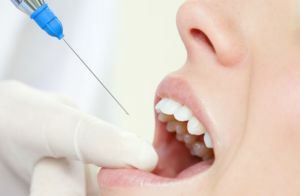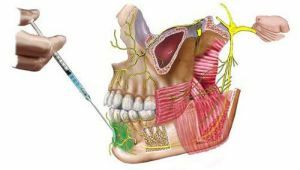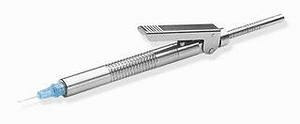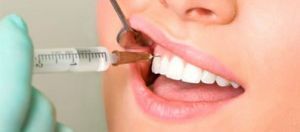 Almost every person when visiting a dentist is afraid. In addition, very often the process of treatment of dental diseases can bring discomfort and severe pain.
Almost every person when visiting a dentist is afraid. In addition, very often the process of treatment of dental diseases can bring discomfort and severe pain.
That's why it's hard to imagine the work of a dentist without the use of local anesthesia. On the one hand, anesthesia eliminates all negative emotions and fear in the patient, on the other - allows the doctor to work according to the plan of treatment.
Contents
- Purpose of anesthesia in dentistry
- What does modern anesthesia offer?
- How much does anesthesia go away?
- Allergic reactions
- Other possible troubles and consequences
Assigning anesthesia in dentistry
Many people ask themselves: when and in what situations is anesthesia used in dentistry? Contrary to many misconceptions, it is used not only during tooth extraction.
This is not really true. Local anesthesia will allow the dentist to carry out all manipulations in a relaxed environment, as he will be absolutely sure that the patient does not jerk at an unnecessary time, as there will be no pain.
And the patient himself will stay much calmer and more comfortable, because he will not be constantly in a state of waiting for pain.
Most often, local anesthesia is used during the treatment of gingivitis, periodontitis, periodontitis. However, it has also been established that the third  part of the pain effect itself creates the noise of the drilling machine.
part of the pain effect itself creates the noise of the drilling machine.
In modern dental clinics it is difficult to find it, since lasers and sandblasters are increasingly being used. But still, local anesthesia remains an integral part of dental surgery, which is certainly accompanied by pain.
What does modern anesthesia offer?
 Regardless of the type and form of the anesthetic, the principle of action is the same: the selected agent acts directly on the nerve impulse, which is responsible for the pain.
Regardless of the type and form of the anesthetic, the principle of action is the same: the selected agent acts directly on the nerve impulse, which is responsible for the pain.
The peculiarity of anesthesia is that after a while it starts to dissolve and be excreted from the body, during which time a person can feel the pain that will pass with successful treatment.
Now several types of local anesthesia in dentistry are used:
- Application .A special feature is a short exposure. This type of anesthesia is available in the form of a spray or gel. Used exclusively for minor dental manipulations or short in time. Also, application anesthesia can be used as an auxiliary, in order to not hurt to do a deep anesthetic.
- Infiltration .Anesthetic of this type is injected with a prick under the gingival mucosa, intraosseously or under the periosteum. Used when cleaning the tooth canal. The effect lasts about 1 hour.
- Conductor .This type of anesthetic drug is also injected, however, into the branch of the trigeminal nerve branches. During this procedure, the patient may experience pain, which should be reported to the doctor, after which he can make another injection that will remove the pain from anesthesia. Conductive anesthetics are used during manipulations with molars( treatment and removal), operations on the gums, removal of the nerve, and prolonged dental manipulation.

Intraligamentary anesthesia is done with such a syringe
- Intraligamentary .The impact occurs only on one tooth, with which further manipulations will be carried out. For this, the anesthetic is inserted around the diseased tooth. Usually, it is used when removing wisdom teeth or serious dental operations. This will relieve unnecessary strain of the patient, as well as increase the effectiveness of another anesthesia.
In addition, there are features in anesthesia of the upper and lower jaw. This is due to the structure of each of them( to carry out anesthesia of the upper jaw is much easier).
Often numb in the complex and cheek, and lips, and tongue. This is due to the fact that the exits of the nerves of these organs are in close proximity.
How much does anesthesia go away?
The duration of the action of the anesthetic depends on the type of preparation:
- For example, those that are applied to the surface of the cheeks or gums of the are effective for only a few minutes.
- When the anesthetic is injected into the upper jaw of the , the frost effect can persist for up to 2.5 hours, depending on the individual characteristics of the organism( the age of the patient, the activity of his kidney and liver, etc.), the depth of injection and the amount of the drug that has been injected.
- When carrying out work with the lower teeth of , the anesthetic should be injected more deeply. Because of this, the drug is withdrawn much more slowly and the effect of freezing can last about 4 hours, sometimes even longer, depending on which tooth is being anesthetized( the farther it is, the more the drug is required).
Allergic reactions
 Very often, when using local anesthesia, there is an individual intolerance of the components of complex anesthetics.
Very often, when using local anesthesia, there is an individual intolerance of the components of complex anesthetics.
Simply speaking, there is an allergy to anesthesia, in dentistry there are two types of reaction to anesthetic:
- contact dermatitis, which is characterized by swelling in the place where the drug was administered;
- urticaria and anaphylactic shock - this manifestation of allergies is quite rare.
That's why when using anesthesia the doctor conducts a test for the possibility of an allergic reaction to a particular drug.
Many patients confuse palpitations, chills, dizziness and increased sweating with an allergic reaction. However, the true allergy is the result of the hypersensitive state of the body, which is caused by the ingress of an allergen into it, which is one of the components.
Symptoms of this reaction are:
- rashes on the skin that are accompanied by itching;

- shortness of breath;
- anaphylactic shock in severe cases.
All the seriousness of the allergy is largely exaggerated. With a penchant for her, the doctor selects the drug to minimize the unpleasant consequences. Possible itching and redness, as a rule, disappears in a few minutes.
Other possible troubles and consequences of
In addition to allergies, other unpleasant side effects may occur. Avoid them sometimes can not, in view of the fact that it is difficult to predict the reaction of an organism to a given drug.
However, there is no need to worry about this, since the safety technology of the clinic necessarily contains points in which the rules of behavior are prescribed in the event that after anodic treatment for a long time does not pass.
Among the side effects the most frequent are:
- abnormalities in the functioning of the stomach;
- pain in the throat and mouth, headache;
- chills;
- general malaise, which is accompanied by an aching bones and drowsiness;
- loss of ability to concentrate;
- skin reactions: itching and redness.
More serious and dangerous consequences are possible, for example:
- infection in the lungs;
- damage to the healthy tooth, tongue, lips or partial killing;
- premature withdrawal of anesthesia.
In the event that the amount of the drug was incorrectly calculated, and there were violations in the procedure for the administration of anesthetic, the following possible consequences:
- nerve damage, usually partial;

- necrosis of nerve cells;
- anaphylactic shock;
- killing cells of the eyeball( partial);
- brain damage;
- death.
To avoid these effects, it is necessary to seek qualified help in time. For this, the patient must clearly know the specific features of the anesthetic that the doctor uses, namely how much the frost remains and the time it takes to get rid of anesthesia after the manipulations.
As a rule, the sensitivity is completely restored within 2-4 hours. You should contact a doctor for help if, after this time( plus 30 minutes), the condition does not return to normal.
The doctor needs to say what remedy was used, whether other medications were taken, whether there are chronic diseases, in particular, renal or heart failure, diabetes mellitus.
Based on these data, the doctor decides on the methods of care. In some cases, hospitalization or administration of an antidote may be required, which will eliminate the frost effect within half an hour. To inform the doctor it is necessary and in the event that a pain after a tooth extraction is too strong.
To prevent the occurrence of complications, abstinence from food will help for two hours after the freezing of the frost. This rule, as well as other instructions of the doctor, is not recommended to be neglected, since in most cases the unpleasant consequences arise precisely because of the patient's own fault.
